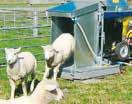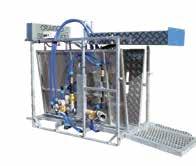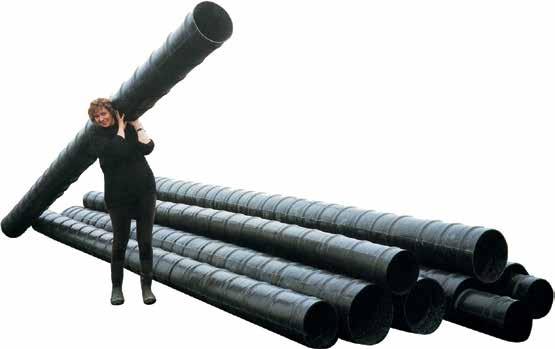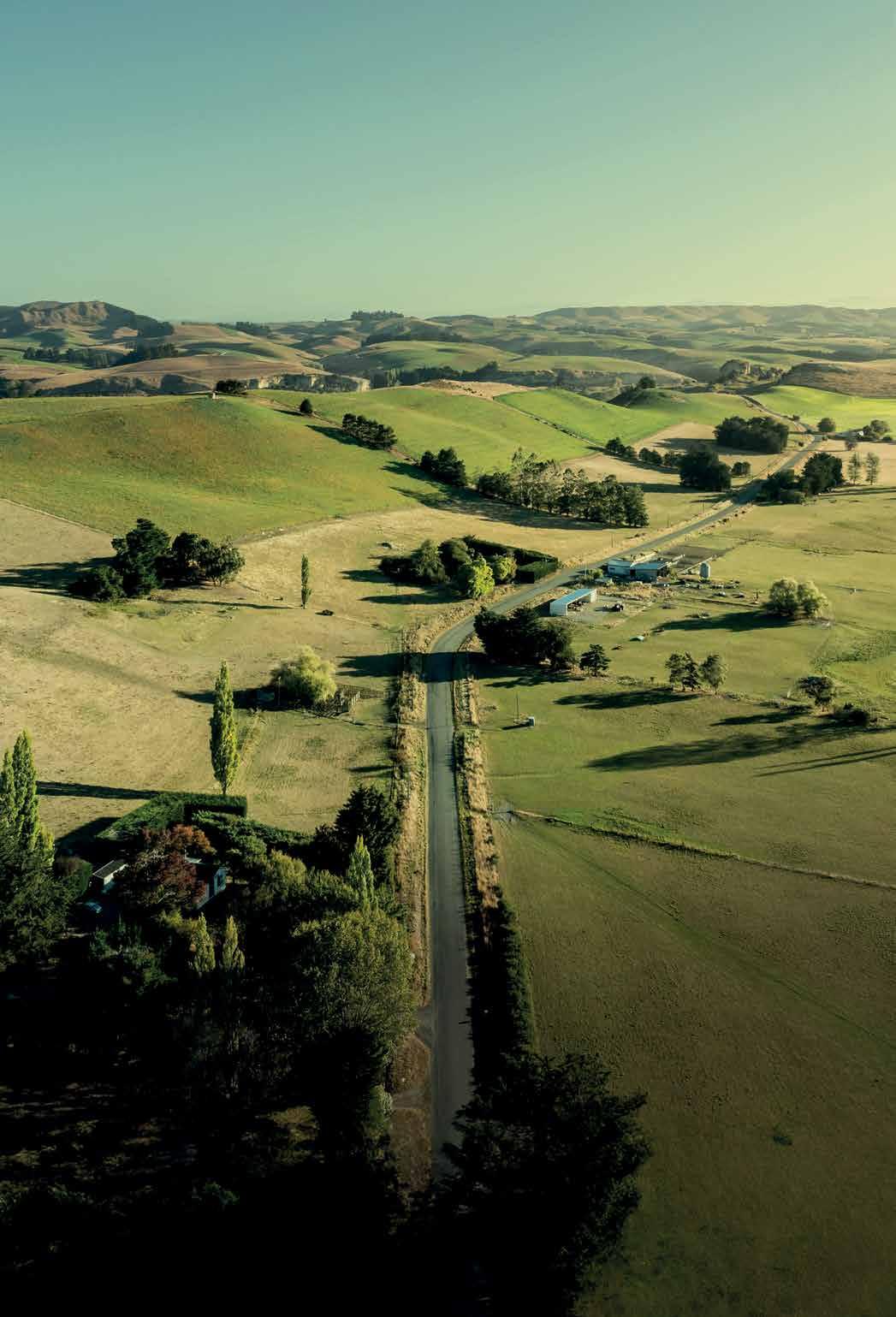






DAIRY FARMING leader Richard McIntyre is contesting the 2024 DairyNZ director elections.
The Horowhenua farmer and Federated Farmers dairy section chair says he’s passionate about farming and wants to contribute to the industrygood organisation.
“I can see the challenges we’re facing, and I think I can make a real contribution at the board level,” he told Rural News.
McIntyre is the second high-profile candidate for the director elections. DairyNZ deputy chair Jacqueline Rowarth, who is retiring by rotation, is seeking re-election as a director.
McIntyre has been a dairy farmer for 24 years. Originally a townie, McIntyre started out as a farm assistant and worked his way up to become a herd owning sharemilker. He also has a calf rearing business and a 180ha drystock farm.
McIntyre has been part of Federated Farmers for 11 years where he has chaired the sharemilker section and served as vice chair of the dairy section before taking up the chairmanship in 2022.
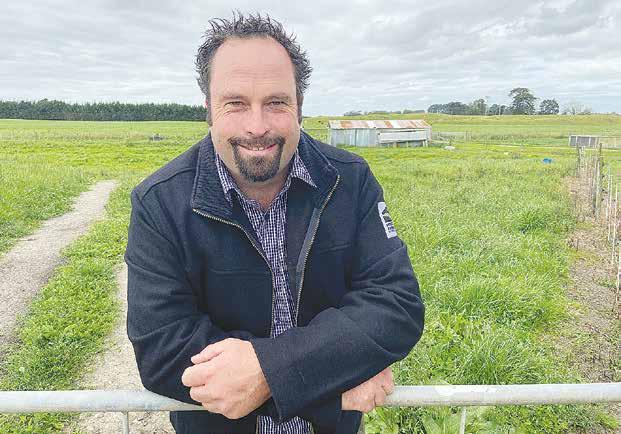
Farmers also want to see DairyNZ focusing on their core roles of research, science, and extension to help address those challenges.
If successful, McIntyre says he won’t be stepping down from his Federated Farmers role.
“I love my role at Federated Farmers and take the job incredibly seriously.
“My term as Federated Farmers dairy chair ends in June next year. I’d want to see my term to the end, finish what I’ve started, and then I’d reassess where things are at.
“Any potential conflicts would be carefully managed, but I don’t see any major issues. At the end of the day, both organisations work for farmers.”
He points out that several DairyNZ farmer-elected directors sit on other boards like Ravensdown, Ballance AgriNutrient, and the Deer Industry Association.
“I don’t see any reason why Federated Farmers should be treated any different,” says McIntyre.
McIntyre believes that the skills and networks built at Federated Farmers would be an asset for DairyNZ and make a real difference for farming families.
that things have gotten off track.
“DairyNZ is a great organisation, and I’m a big supporter of the levy, but there is a real feeling out there now
“Farmers are struggling with some major challenges right now with increased costs, reduced incomes, and squeezed profits.
“We’re also struggling to fill gaps in our workforce, and there’s a huge wave of environmental changes coming at us.”

He says farmers are looking to DairyNZ for practical solutions to some of those challenges – improving productivity, reducing environmental footprint, and increasing profit.
McIntyre’s governance roles include being a current member of the Fish and Game Wellington council. He has served as chair of the NZ Dairy Industry Awards Trust and did an eight-month stint as associate director of DairyNZ.
WORKING DOG GOALS
We’ve all been there… It’s been a big morning of mustering in the hills, and you’re cold, wet and muddy. Smoko is tantalisingly close. The sheep are almost right where you want them, and then…
Your dog’s brain appears to actually switch off. Like a light. They stop listening to commands, lie down in exactly the wrong spot, or decide to just start freestyling. Sheep swirl away from the gate – a bleating mass of ovine confusion. Commands to your dog are met with a curious head tilt and an innocently raised ear. Dreams of hot black tea (and perhaps even a biscuit), vanish mirage-like.
When your dog experiences mental fatigue, the frustration is real! Though physical fatigue is often a contributing factor, there can be more to it. The question is… Can the right diet, help your dog focus for longer?
Your working dog’s brain works as hard as their body. So whilst they definitely need nutrition for physical stamina, they need it for mental stamina too. Their brain processes a
constant stream of information. It listens to commands, makes decisions, and directs the body – often for hours on end. All of this uses lots of nutrients. So, what equals doggy brain food?
Glucose
Mammalian brains – including yours and your dog’s – use glucose as their major fuel source, so it’s no surprise that brain function is closely linked with glucose levels. Glucose that is consumed by your dog (in food) and not used immediately, is stored in their liver and muscles as glycogen. Then, when they’re working, glycogen is converted back to glucose to fuel their body – and their brain.
Which begs the question – what foods provide glucose?
Protein and fat help provide your dog with sustained energy for whole body stamina, and the amino acids in protein provide some glucose. Carbohydrates (like the starch in rice) also provide a source of glucose.
CopRice Working Dog food contains a balance of all three. It is high in bioavailable protein (meat is the number one ingredient for a reason) and fat. It also contains Australian-grown rice which provides the body with a natural source of glucose.
Antioxidants
Diets rich in antioxidant nutrients – such as Vitamins E and C, Zinc and Selenium – help support your dog’s immune system. This in turn helps support overall health and wellbeing. With these benefits in mind, CopRice Working Dog food also contains optimal levels of antioxidants.
As the owner of handy dogs, you know only too well that your dogs’ breeding, training and fitness all play a major role in how long they can keep their mind on the job. But nutrition that stacks up is also key. When it comes to feeding for hard work – which includes mental stamina – the CopRice Working Dog range has been carefully crafted, to keep them working at their peak for longer.



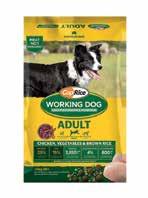

Phone: 09-307 0399
SUDESH KISSUN sudeshk@ruralnews.co.nz
FORMER FEDERATED Farmers immigration spokesman and Waikato farmer Chris Lewis is questioning Immigration New Zealand’s (INZ) accredited employer scheme.
He says being an accredited employer with INZ isn’t helping dairy farmers secure visas for overseas workers. He says the scheme is “almost farcical”.
“Farmers pay to become accredited employers, it’s a time-tested process, farmers must have a long history of being good employers and keep good records,” Lewis told Rural News
“But it’s still taking us four to five months to get a visa for overseas workers.”
It also costs employees around $740 per visa application, plus the cost of hiring and lost productivity from being a person down. Lewis questions whether it would take INZ four months to verify documentation.
“With all the money they get for each visa application, they can easily hire extra staff and set up a dedicated team to quickly go through a four-page visa application.”

Lewis is in the process of hiring two extra workers from the Philippines. They are related to two longserving migrant workers on his farm. One has got a visa and is now working on the farm.
He has gone through the INZ process of advertising for the job in NZ. But he points out that the application has been with INZ for three to four months.
Lewis, who was Federated Farm-
ers immigration spokesman and dairy group chair, says the process was always tedious under previous governments as well.
But being an accredited employer has brought little benefit.
Lewis has dealt with Immigration Ministers for many years on the issue of visas for migrant dairy workers.
He says while all ministers showed the right intent, they could do little to improve the operational side of INZ.
“The ministers, including the current one, have great intent and always listened to our grievances, but the department has failed to lift its performance.”
According to Federated Farmers, the dairy sector needs up to 1000 workers for calving season, which started this month in the North Island.
Lewis points out that post Covid the dairy sector needed 3000 migrant workers but with business costs tight and interest rates high, farmers are not hiring as many staff.
There are also more Kiwi workers available as construction and roading projects have dialled back due to economic issues.
On his farm, Lewis says 20% of the herd has calved. Lewis and his wife have been working full time and his son helped during the school holidays.
“That extra help we got during the school holidays is now gone, so farmers will be relying on Kiwi workers and migrant workers to get through calving,” he says.
Rural News contacted Immigration NZ for a comment, however they couldn’t meet our print deadline. INZ’s comments will be posted on our website alongside this story.
JESSICA MARSHALL jessica@ruralnews.co.nz
HORTICULTURE NEW Zealand
Rural News online: www.ruralnews.co.nz
Subscriptions: subsrndn@ruralnews.co.nz
(HortNZ) chief executive Nadine Tunley says the industry-good body’s support for growers has proven to be multifaceted.
In her chief executive’s message –her last before she departs HortNZ in August – Tunley says that in the aftermath of Covid-19, Cyclones Hale and Gabrielle, and amid continued inflationary pressure, the organisation has worked hard to support its growers in


their efforts to rebuild and recover.
“Our efforts have been multifaceted, focusing on continued relief, advocacy for long-term support, and providing practical resources to help growers get back on their feet,” Tunley says.
She says the organisation has worked to facilitate access to Government, lobbying for officials and Ministers to see and hear first-hand the current challenges and constraints.
“The policy team work tirelessly with local authorities and central Government to streamline processes
and outline where existing or proposed policies are untenable and often unworkable,” Tunley explains.
The report reveals more than 4500 commercial growers grew more than 100 different types of fruit and vegetables.
They exported $4.67 billion in horticulture exports - $3.94 billion in fruit and $0.73 billion in vegetables. Domestic sales were $2.81 billion$1.10 billion in fruit and $1.71 billion in vegetables.
Meanwhile, she says labour is still a significant issue for growers,
adding that the Recognised Seasonal Employer (RSE) scheme plays a significant role in the labour ecosystem.
“HortNZ holds strong and trusting relationships with both the Government and our Pacific partners where we advocate for our growers.
“Ensuring access to a reliable seasonal workforce is essential for planting, maintaining, and harvesting crops, and any shortfall impacts the entire sector,” Tunley says.
“Without the support of a robust seasonal labour supply, growers’ businesses are put at risk.”
Minimises pump operation •Available in 20/25/32/50mm




THE GLOBAL push to reduce farm methane emissions is threatening to become both a market trait and a trade barrier issue, warns Beef+Lamb NZ genetics specialist Dr Jason Archer.
Speaking at the B+LNZ Genetics Sheep Breeder Forum in Christchurch, Archer outlined some findings from a recent fact-finding world tour, saying there was now a global effort to reduce methane, with emissions targets now being baked into countries’ legislations.
While he said he did not want to talk about methane, it could not be ignored.
“Yes, it’s not everyone’s favourite topic. No, Beef+Lamb does not support paying a tax on this. But out there it is fast becoming a market trait and I really do think it will be used as both a
market trait but also a trade barrier trait potentially.”
Archer said that every talk at conferences were either directly about methane, or linked back to emissions.
“So you talk about cow efficiency or cow size and they turn it around and say this is the impact on emissions intensity.
“I’m not trying to preach to you in terms of where we need to go but that is the reality of the conversation that’s out there internationally.”
One example was a pair of New Zealand wool marketers he met in Chicago, where they were trying to present New Zealand wool products at a big trade fair for the commercial furnishings industry.
While wool furnishings had “a great story” in terms of being fireproof and biodegradable at end of life and so on, the Kiwis were having trou-

ble trying to tell the story around methane.
He said it was nonsensical that our natural product was having to compete against “recycled oil” but the reality
was that carbon footprints are now being baked into building regulations.
“Everyone is asking them about the carbon footprint of their prod-
uct, because of the building regulations.
“It’s an unavoidable conversation that they we’re having and they’re desperately trying to work out what the
story is that they can tell around that.”
Another example was Ireland, where farmers export about 200,000 calves annually to Spain and the Netherlands.
Archer said they are now worried that trade will be shut down, either over perceived animal welfare reasons or because the ferry transporters “just don’t want the look”.
The Irish farmers’ concern was not the feeding and management of those calves if they had to stay in Ireland, but what that would do to their national emissions profile.
“It seems pretty artificial, right? Because those calves are going to go and get fed somewhere else. But that’s the world we live in right now. That is the reality.”
“I would really like to tie the conversation with methane into being able to get feed intake and feed efficiency information.
“If we’re going to deal with methane, what we’ve actually got to deal with is the emissions per kilo of feed intake. Not the intensity or anything like that, but we’ve actually got to make our animals more efficient.
“And the second reason is, let’s get something useful out of this while we’re doing it. Let’s use the opportunity to get that feed intake data and to drive the efficiency, and there are going to be some spin-off benefits.”
@rural_news
Archer said that in some areas, New Zealand research was well behind some of what he saw overseas but “right up there” in others, thanks to the efforts of AgResearch, and also B+LNZ’s investment long ago in the Pastoral Greenhouse Gas Research Consortium.
facebook.com/ruralnews
FARMER CONFIDENCE has fallen despite the new Government repealing and rewriting some contentious regulations.
Federated Farmers’ latest Farm Confidence survey of 1400 dairy, sheep, beef and arable farmers shows confidence remains stuck in historically low territory.
The survey results, released this week, shows debt, interest rates and banks causing the greatest concern to Kiwi farmers.
“It’s incredibly frustrating to see
farmer confidence is still sitting at these stubbornly low levels,” Federated Farmers national president Wayne Langford says.
“Unfortunately, these survey results are just reflecting how farming families are truly feeling out there now.
“Farmers have really been doing it tough for some time now, with high interest rates, low commodity prices and sky-high input costs making it really hard to earn a living.”
Langford says Federated Farmers

were encouraged by a slight lift in farmer confidence shown in its January 2024 survey – but things have since gone backwards.
“Restoring farmer confidence is a huge focus for Federated Farmers. It’s what gets me out of bed each morning, feeling motivated to make a difference.
“We clearly have a big job ahead of us, but we’re up for the challenge. We’ll keep pushing hard to improve the lives of farming families across the country.
“The Government have done a lot of work repealing and rewriting some of the most unworkable regulations, but there’s still so much more to be done.”
But the six-monthly survey clearly shows it’s not only regulation that’s eroding farmer confidence, Langford says.
“There are a whole range of other issues that are also having an impact.
“These include concerns about banking, high interest rates, soft farmgate prices, the ability to find staff,

and the general economic outlook for the country.
“Farmers will also be watching interest rates closely and desperately hoping for a rate cut later this year to help relieve some of the pressure they’re feeling.”
Carried out in mid-July, the survey found more farmers consider the current economic climate to be ‘bad’ compared to January.
This is the second-worst result in the survey’s history, with the lowest being July 2023.

A WARNING to the red meat sector that competition in many of its key markets is heating up. This comes from the Director General of the Ministry for Primary Industries (MPI)
Ray Smith in a keynote address to the Red Meat Sector conference in Wellington last week.
He says relying on ‘brand New Zealand’ won’t be enough to ward off the many meat producing countries that are exporting to markets in which NZ has had something of a privileged position for years.
Smith says, for example, Australia has increased the volume of sheepmeat it exports while South America has increased its beef exports.
His warning to the sector was one of the key

THE MEAT industry is launching a campaign in China to make consumers aware of the unique health attributes of New Zealand’s grassfed animal meat.
Meat Industry Association( MIA) chair Nathan Guy says, while NZ has an FTA with China, 40 other countries also have access to that market and the time has come to make a big push to tell consumers that our products are better than our competitors.
“A problem we have in China is that consumers look at the supermarket shelf and they see grain-fed beef which they consider superior. It’s higher priced and gets a premium, while our lean beef tends to be seen as something of a commodity, and we must change that and other misconceptions,” he says.
To do this, MIA, meat processing companies and Beef+Lamb NZ are jointly developing a new supercharged and refocused version of the Taste Pure Nature awareness programme.
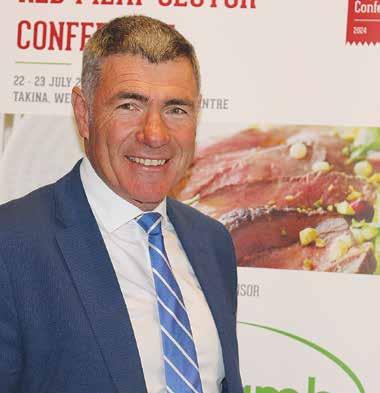
The new campaign will be industry led and funded, hopefully with government help. MIA and B+LNZ have agreed to put in $2 million each over three years and they hope the government will make a similar contribution.
According to Guy, it will be up to the marketing managers of the processing companies to devise the programme.
“We are going to call it ‘country of origin’ and it will be around our natural attributes: animals, outdoors, health and nutrition – all the great attributes that are currently
lost in translation in the market. Our competitors are making similar claims, so we can’t afford to sleepwalk given that competition is so rife in China. Doing nothing is now not an option,” he says.
Guy says they plan to launch the campaign at a huge food expo in Shanghai in November.
– Peter Burke
access to developing markets. Issues such as FTA’s and having quality international relationships in key forums to state NZ’s case were also advocated.
Smith says NZ has to make sure that high value consumers understand the full range of attributes our grass-fed products offer and that they
RAY SMITH acknowledges the tough times that sheep and beef farmers are going through in terms of loss of profitability and says he’s been to many of the regions hammered by weather events. He describes the situation as heartbreaking.
“But I want them to hang on to is the fact that all the indicators are that we will return to a positive position,” he says.
Smith says recovery for the red meat sector will take about two years, but the worst is over and prices are starting to come back. But he believes when they do come back, they will not be at the same high level as they were.
He says there are many positive things going on for the red meat sector. He notes NZ protein is still sought after by the growing middles classes in our markets and believes that because of our farming systems, climate change will have less impact on our farmers than our competitors.
“Our production system is highly efficient it doesn’t rely on a whole lot of imported feed or other grown feed, and I think that will give us an advantage over the countries that we compete with,” he says.
are better in every respect to grain-fed animal products.
“We must work hard to see that this proposition resonates with high-paying customers. Remember that NZ is targeting customers with a product that is higher in value and we are looking for those higher value customers to find their way towards our prod-
• DairyNZ Board of Directors
• DairyNZ Directors Remuneration
uct. There is quite a bit of work to do in market but there is quite a bit of opportunity there for the taking,” he says.
Ray Smith says MPI is reorganising its own capability in market access and trade to put greater focus on ensuring NZ companies maximise value from existing FTA’s. @rural_news facebook.com/ruralnews

Invitation for 2024 candidate nominations – three positions available
• Two directors for the Board of DairyNZ Incorporated.
• One member for the DairyNZ Directors’ Remuneration Committee.
Current levy-paying dairy farmers are now invited to nominate candidates to fill these three positions.
All farmers paying a levy on milksolids to DairyNZ are eligible to stand for election.
An information pack outlining desired criteria and nomination requirements for the positions can be obtained from the Returning Officer.
Nominations must be received by the Returning Officer by 12 noon on Friday, 9 August 2024.
Elections
If more than the required nominations are received, a voting process will be carried out by postal voting using the STV (single transferable vote) voting method. Votes will be weighted by annual milksolids based on 2023/24 dairy season ended 31 May 2024. Voting credentials will be posted to all registered DairyNZ levy payers on 18 September, with voting closing at noon on Thursday, 17 October 2024.
The DairyNZ Annual General Meeting will be held on Tuesday, 22 October 2024. Election results will be announced at the meeting.
For further details contact the Returning Officer below.
Anthony Morton Returning Officer – DairyNZ Incorporated 0800 666 935 iro@electionz.com

NEW ZEALAND must be front and centre of international discussions affecting the red meat sector.
That’s one of the key messages from Beef+Lamb NZ chief executive Sam McIvor who leaves that role to take up a new one as chief executive of Ospri later this week.
McIvor has headed B+LNZ for the past eight years but has worked there in other capacities for 17 years. He’s also worked for Ospri in the past.
McIvor told Rural
News that having strong international relationships in multiple forums will be crucial for NZ in the coming 10 years. He says we will be consistently challenged about the right to farm animals for food, how we care for them and justify that to people who see it unnecessary to kill animals for food.
He says the industry will also face conversations around climate change, biodiversity emissions reduction and livestock’s environmental footprint.
“There will also be discussions around the nutritional value of red meat and its co products
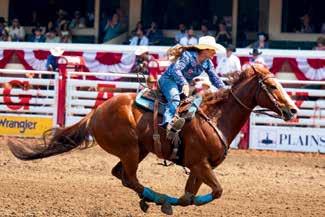


and we absolutely have to be at the forefront of any international dialogue on all of these subjects,” he says.
McIvor says, in conjunction with this, B+LNZ and the wider industry needs to give clear signals to farmers as to how they can best invest and adapt to the change that will inevitably occur. In that regard, he says technology is changing at a mas-
sive rate and while things like AI have been promised for a long time, it feels that it is here now.
“So we as a sector have to embrace technology, whether it’s to reduce costs, increase our efficiency or produce cost-effective verification and assurance. We have got to get our heads around that,” he says.
McIvor says in his new role at Ospri, technol-
ogy will play a huge role in enhancing traceability systems and linking up with all those who are involved in the sector. He says in the past there was no great interest in sharing data, but there is a lot more maturity now and the value of data sharing will need to become the norm right through the value chain.
@rural_news facebook.com/ruralnews
THERE WAS one outstanding achievement that Sam McIvor can bask in the glory of from his time as chief executive at B+LNZ and that is the much-improved relationships across the wider primary sector.
He believes that B+LNZ has been a real catalyst for pulling the industry together and points to the much closer relationship between MIA and his organisation. He adds that the relationship with with one of its key partners, DairyNZ, is also solid and also points to the vastly improved relationship with MPI.
McIvor says the huge amount of trust that’s been built up means that all parties are now recognising their respective knowledge and skills which bodes well should NZ have to deal with something like an outbreak of foot and mouth disease.
“The industry has had a huge number of common challenges to deal with in the last six or seven years, such as Covid and M.bovis, as well as well as regulatory uncertainty.
You can’t deal with these challenges on your own and it’s the good relationships that have got us through many of the crisis that we as a sector have had to deal with,” he says.
McIvor says he is extremely proud of what his team has achieved, including the Red Meat Profit Partnership, Taste Pure Nature and the development of B+LNZ’s environmental strategy. He says participation B+LNZ’s own awards, along with Ahuwhenua awards, have been high points for him.
He says good news has come with the free trade agreements with the UK and the EU.
He says one of the challenges is for NZ to extract the maximum amount of benefit from these and it’s a wellknown fact that up to 40% of the value of an FTA can be lost in implementation.
McIvor believes productivity in the sector needs to improve and says it’s stagnated a bit in the last few years. He also believes that NZ still lacks some of the tools needed for on-farm measurement and verification. He says ongoing develop of the organisation’s R&D platform will be key in the future.
Calgary Stampede & The Rocky Mountains
Jul 5th, 2025, 16 Days
Embark on a 16-day adventure through the heart of Canada's stunning landscapes and vibrant culture. Experience the thrill of the Calgary Stampede - world-class rodeo action and the Chuckwagon event.
Indulge in luxury aboard the Rocky Mountaineer Train from Banff to Vancouver, passing through the majestic Continental Divide. Discover the natural






PERFECT PARTNER PASTURE’S

















COVID-19 TOOK global shipping rates to mind boggling highs, but over the subsequent 12-15 months they returned to more sustainable levels. Fast forward to July 2024 and rates have nearly doubled over three months.
The main reason is the current disruption in the Red Sea, where Houthi rebels are targeting ships linked to Israel, the US or Britain, as part of their support for the militant group Hamas in its war against Israel.
This has impacted global shipping capacity, particularly for vessels that service European and Asian routes. Since December 2003, authorities report a near 50% fall in ships traversing the Suez Canal, with a reduction of around 40 vessels per day.
In contrast, this reduc-

tion is offset by a 70% increase in vessels navigating the less direct Cape of Good Hope, which increases the distance travelled by 40% and adds delays of two to five weeks.
Compounding the issue are a global shortage of shipping containers and congestion at some major Asian ports. At the same time, global export demand is recov-
ering following the postCovid lull of 2023, with the World Trade Organisation predicting a 2.6% increase in exports for 2024.
The rising cost of doing trade, particularly if the problem deepens, poses a risk to the New Zealand economy, already facing high interest rates, margin pressure, wage rises and climbing unemployment. Any sustained
rise in shipping costs is likely to complicate the Reserve Bank’s task of getting inflation back to its 1-3% target band.
Fortunately, the current rise in shipping costs is expected to be less inflationary than the surge experienced during Covid-19. Container production, largely driven by demand to move exports from China to the West, has increased substan-
tially over the last few months, while the disruptions experienced in the Panama Canal appear to be easing. Although a much smaller chokepoint than the Suez Canal, it still accounts for around 7% of global seaborne trade. The ‘Panama Problem’ was caused by an extended drought in 2023 that reduced the number of vessels able to use the canal and led to draught
limits that reduced operating weights.
Currently, water levels in Lake Gatun, the main body of water that feeds the system, have been rising steadily since April, meaning that by early August, up to 34 ships per day will be able to use the canal. This is a major increase on the 24 vessels per day that had access at the start of the year and not far behind the more
typical 36-38 vessels that use the canal in normal times.
Further complications to global shipping include an increase in off-schedule arrivals, which are deeply impacting logistics management and increasing congestion at some Asian ports. Key locations such as Singapore and Shanghai are experiencing extended delays in entering the ports and increased unloading and loading times. In some cases, they are unable to load enough empty containers, with captains choosing to leave ports partially loaded to try and regain schedules, with a resultant shortage of empty containers in Oceania.
Industry sources suggest that the true effect of the increased costs might take a little while to show up accurately, with data collection typically three to six months in arrears.
HERD IMPROVEMENT company
LIC paid over $2 million worth of credits to farmers caught up in a semen quality issue in October last year.
The credit and goodwill packages, together with a reduced milk price environment, a subsequent reduction in activity driving a lower bull valuation, ongoing cost inflation and tax changes caused LIC’s net profit after tax (NPAT) to plunge 71% to $7.7million for year ending May 31, 2024.
Total revenue for the year was down 3.3% from previous year to $276m. Total assets also dropped 6.2% to $359m.
LIC chairman Corrigan Sowman says the 2023-24 financial year has produced some difficult conditions for the co-operative.
But despite challenging conditions, the board presented a positive result to farmer shareholders, for the seventh successive year, Sowman says.
“Our farmer shareholders are the heart of our co-operative, and it has been a particularly difficult year for them with a lower milk price environment alongside continuing high input and debt servicing costs. The impacts of the lower milk price were felt across New Zealand, which is reflected in the 3.3% reduction in revenue,” he says.
“LIC is committed to its farmer shareholders, and we have continued to invest in research and development, quality improvements in

our semen laboratories and technology innovation that will benefit their businesses and the sector’s needs now and into the future.
“Throughout the 2023/24 financial year we have identified cost savings to offset reduced revenue, and this has
allowed the co-operative to still post a profit and pay out a dividend to our shareholders, which is in addition to the $18.5m special dividend paid earlier this year of 13 cents per share.”
The semen quality issue impacted 1127 herds. Some batches of semen
that were inseminated on farms on 17-19 October and 23-25 October may have been contaminated by bacterial infection. Cows did get in calf from the inseminations on the affected days, but a noticeably lower number than LIC would expect.
Tax legislation enacted in March 2024 removed the ability to depreciate commercial buildings for tax purposes from the 2024/25 income tax year.
The application of this tax change created a one-off, non-cash accounting adjustment of approximately $4 million to increase tax expense at year-end, with a corresponding increase in LIC’s deferred tax liability balance.
Research and development investment increased by 14.2% to $21.2 million, representing 7.9% of revenue. Investments include a methane research trial focused on investigating the potential to breed low methaneemitting cows in the future, as well as a heat tolerance research programme which involves breeding high genetic merit dairy cows with improved heat tolerance.
The proportion of fresh semen straws used for breeding replacement daughters on farm from LIC premium bull teams increased to 79.4% and target turnaround times were achieved across GeneMark, Johne’s Disease, and milk pregnancy testing. Johne’s Disease testing saw a 10% increase, with 1.18 million ani-
mals tested during 2023/24.
LIC’s herd management system MINDA saw notable improvements during the period, integrating with milk processors such as Fonterra and Open Country as well as integrations with wearable providers and OSPRI. This enables seamless data-sharing and integration across multiple applications used on farm. MINDA is now used by 90% of dairy farmers in New Zealand.
Sowman says, although the coming year still presents a difficult economic environment with ongoing cost pressures on farm, LIC will continue to be firmly guided by its primary focus of delivering on its three commitments to farmer shareholders: operational excellence, faster genetic improvement and software reliability and performance.
The co-operative’s performance against these commitments during the 2023/24 year will be reported on at its annual meeting in September.
The co-operative expects underlying earnings for 2024-25 to be in the range of $16-22 million, assuming no significant events, including climate events, or milk price change takes place between now and then.
LIC shareholders received total dividend of $8.3 million, at 5.84c/ share, representing 60% of underlying earnings.
This is in addition to the $18.5m special dividend paid earlier this year of 13c/share.
PETER BURKE peterb@ruralnews.co.nz
A TSUNAMI of memories hit the tiny Manawatū township of Bulls earlier this month where 300 people gathered to commemorate the 100th anniversary of Flock House – an iconic former agricultural training facility.
The local community centre was packed to capacity for the opening of the event as people listened to speeches and quickly moved into groups to reminisce and learn more about this amazing institution, which produced some great farmers.
Flock House owes its origins to NZ wool growers who, during World War 1, agreed to a deal with the government of the day to buy their wool and later on-sell it. In the end, the government made a profit of 237,000 pounds sterling on the sales and offered this back to the growers. They felt embarrassed by this and decided to put the money into a fund to help the orphaned sons and daughters of Royal Navy, merchant navy and fishermen who lost their lives in the war.
This was in recognition of the navy personnel who took their wool to market or protected the ships that did. The wool growers purchased the Flock House estate in 1922 and converted it into a
Flock House owes its origins to NZ wool growers who, during World War 1, agreed to a deal with the government of the day to buy their wool and later onsell it.
training institute for the orphans to learn farming skills, the first of whom arrived in 1924.
This continued until 1931, by which time about 750 boys had come to Flock House. It should also be noted that a Girls’ Flock House was established in Palmerston North, where daughters of the seamen were trained in cooking and other domestic skills.
In 1937, the government bought the establishment which then offered cadet training in farming to all New Zealanders. It was later used as a conference centre until being sold off by the government in 1988.
It was the descendants of these early arrivals, along with farm cadets and their instructors, who came from across the globe and all parts of NZ to attend this amazing reunion.
The idea of holding the centenary celebrations came from Alasdair Bettles-Hall, whose own father was one of the orphans who came to Flock House in 1929. He says he was reading about Flock
House two years ago when it suddenly dawned on him that the 100th anniversary was coming up.
“So quite frankly, in my morning shower the bones of this project came together. Firstly, to tell the stories of the 759 orphans and their descendants and secondly to hold a reunion of all those who had been associated with Flock House over the years,” he told Rural News
The inspirational shower turned into a raging success attended by lots of New Zealanders, a contingent from Australia and one woman from the UK whose great greatgrandfather was one of the original orphans.
Bettles-Hall is extremely modest about his own involvement and credits a great committee, which he chaired, for its success. The reunion involved a gathering in Bulls with opportunities to visit the local museum, which has a feature on Flock House, and a special dinner at the Awapuni Racecourse near the site of the Girls’ Flock House.
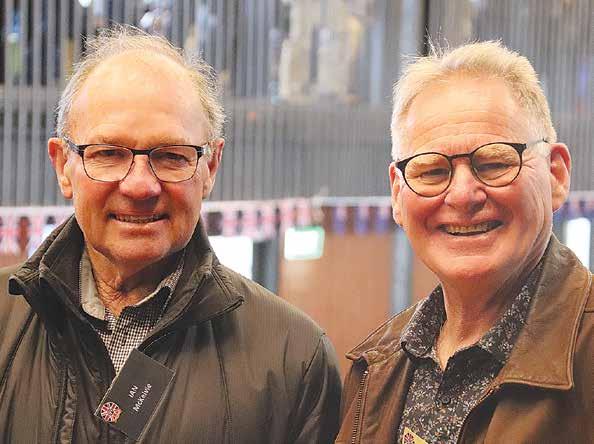
EVERY ONE of the 300 attendees at the reunion had their own personal or family history stories about Flock House.
One of the more famous was former All Black coach J.J. Stewart who was the principal at the institution from 1969 to 1983. He invited the Minister of Agriculture at the time, Duncan MacIntyre, to open a new hay barn. But much to the surprise of the minister it was a new gymnasium.
One person at the celebrations with special links to Flock House was the former MP for Rangitikei, Ian McKelvie.
“My great great-grandfather came to NZ from Australia in about 1853 where he’d made his money selling meat to the goldminers. He lived in Wellington for a while but in 1854 he bought the original Flock House farm. In 1908 his son Lynn,
who’d taken over the farm, built the homestead that stands there today,” he told Rural News McKelvie says the farm was sold in 1922 to the trust that established the training institute. He thinks that it may have been for financial reasons.
McKelvie still lives near the property but says it’s a real tragedy that the homestead and the outbuildings have not been maintained. He says the bill for repairing it would be huge:
“Even greater than fixing Premier House in Wellington”.
He says it’s a pity that successive governments haven’t had the foresight to preserve places such as Flock House.
He also relates the story about one of the early principals of Flock House, Charles Powels, a muchdecorated military serviceman in WWI who returned to NZ with one of the
few horses to come home from the war. The horse was grazed at Flock House and later died there. Every year a special ANZAC commemoration is held near the property for the horse.
While Flock House may crumble a little, the history and the tales of what happened over a century will be preserved thanks to Alisdair BettlesHall and his team.
They are planning to have a book written over the coming years. Already local historian Russell Poole has begun work by initially writing an excellent article in the Manawatū Journal of History. He says he was initially researching the Girls’ Flock House and then moved onto the establishment at Bulls.
“It’s been wonderful story to write and has been a voyage of discovery for me,” he says.


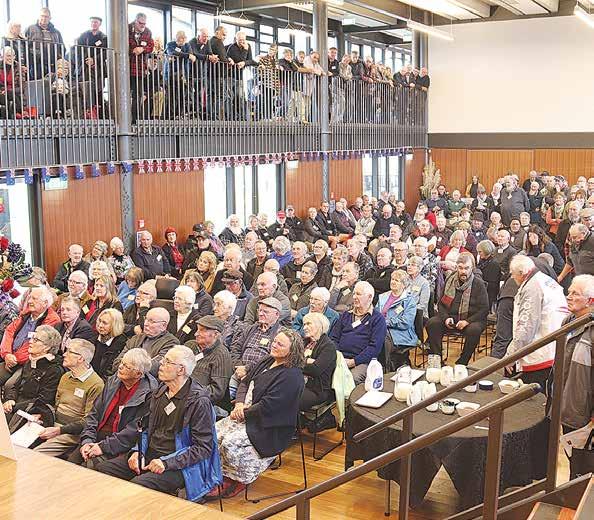

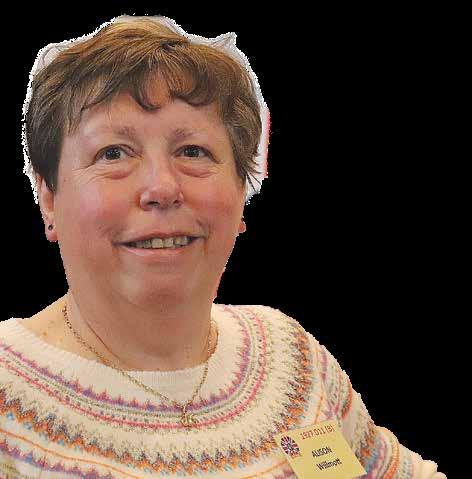

AFTER Jacinda Ardern and Labour were asked to form the government following the 2017 elections, Federated Farmers sent an email out to its executives asking if any of them had a working relationship with any Labour MPs. The answer was no one did.
For the next six years, an avalanche of regulations around water quality, environment, winter grazing and climate change was dumped on the farming sector. While industry body groups like DairyNZ and Beef+Lamb NZ tried to work with Labour on emissions pricing, the rural sector turned its back on Labour, stripping the party of almost all rural seats in the last election.
It’s inevitable that one day, six or even nine years from today, Labour will be returned as the government. And this time, Feds don’t want to be caught short. Hence, earlier this month, Feds leaders hosted Chris Hipkins, Carmel Sepuloni, Willow Jean Prime, Jo Luxton, Jan Tinetti, Rachel Brooking, Tangi Utikere, Glen Bennett and their senior staff for two days in the Waikato. The first day included meetings and presentations. Day two included three farm visits. DairyNZ, Beef+Lamb NZ, Groundswell and Rural Women NZ were also represented.
Feds president Wayne Langford explained that the last few years under a Labour government were incredibly challenging for rural communities, and farmer confidence hit record lows.
“There’s no denying that part of the problem was that we didn’t have strong relationships between Labour and farmers, and there wasn’t a lot of trust or understanding. That’s why we’ve really invested some time trying to establish relationships, grow their understanding of farming, and hopefully build some trust.”
To win back farmers’ trust, Labour will need to show that it’s willing to drop its arrogant attitude, on display during its last three years in power, and show some respect to the farming sector. Talkfests and farm visits alone won’t be enough to win back the rural vote.
GOT SOMETHING on your mind about the latest issues affecting our farming industry? Put your pen to paper or your fingers to your keyboard, and let our readers know what you think. Contact us by either post or email. Don’t forget to put your name and address. Note: Letters may be edited.
post to: Letter to the Editor PO Box 331100 Takapuna , Auckland 0740. or Email: editor@ruralnews.co.nz
HEAD OFFICE POSTAL ADDRESS:
PO Box 331100, Takapuna, Auckland 0740
Phone 09-307 0399
PUBLISHER: Brian Hight Ph 09 307 0399
GENERAL MANAGER: Adam Fricker Ph 021-842 226
EDITOR: Sudesh Kissun Ph 021-963 177
sudeshk@ruralnews.co.nz

A MATE of yours truly has been getting quotes for new carpet in the lounge and, being a good keen man, he was looking first at wool carpet. “Let’s have wool!” he said. He was duly quoted, for “mediumquality wool carpet”, $104 per square metre plus install costs.
“The carpet salesman took great delight in telling us that there are 48 ounces of wool per square yard.
That’s roughly 1.3kg of wool per square metre.” Based on current average crossbred prices of about $3.00/kg, our good keen man reckons the farmer’s getting a bit under $4 per square metre for that $104 piece of carpet. “Looks like wool farmers are being ‘fleeced’ –that’s a hell of a mark up!” he said.

THE TAXPAYERS’ Union has run the ruler over council rate increases and concluded, “Our councils are out of control”. They’ve revealed that the average for city and district councils is an eye-watering 14% hike this year on top of the 15% rate hikes at regional councils. Special mention goes to West Coast, Wellington, Central Hawke’s Bay and Gore for topping the 20% mark. The union also found that at nearly every council, the proportion of spending going to roads, pipes, pumps, etc has been reducing compared to that spent on staff payroll, back-office bureaucracy, etc. Analysts agree non-tradeable inflation, driven in no small part by rates, is key to reducing inflation, yet it’s hard to see any evidence of councils cutting fat and focusing on core services.
PRODUCTION: David Ferguson Ph 027 272 5372 davef@ruralnews.co.nz
Becky Williams Ph 021 100 4381 beckyw@ruralnews.co.nz
REPORTERS: Peter Burke Ph 021 224 2184 peterb@ruralnews.co.nz
Nigel Malthus Ph 021-164 4258
MACHINERY EDITOR:
Mark Daniel Ph 021 906 723 markd@ruralnews.co.nz
AFTER A testy six years between Labour and farming, followed by a sound trouncing in all the rural electorates in the last election, Labour has been doing a full-court charm offensive, trying to build relationships with the various agri leadership groups – rebuilding bridges burned to the waterline during their term in power, when they and the Greens were extremely antagonistic towards farmers. Your old mate is sceptical and reckons, come the next election, Labour and their Green mates will have to burn a different bridge if they really want to retake the Beehive: cut ties with the openly racist extremists they were holding hands with at Election 2023 and may again in 2026 – Te Pāti Māori.
AUCKLAND SALES CONTACT: Stephen Pollard Ph 021 963 166 stephenp@ruralnews.co.nz
WAIKATO & WELLINGTON SALES
CONTACT: Lisa Wise Ph 027 369 9218 lisaw@ruralnews.co.nz
Want to share your opinion or gossip with the Hound? Send your emails to: hound@ruralnews.co.nz
IN THE latest hysterical press release from Greenpeace, the sandal wearers have unleashed their worst conspiracy theorist tendencies, ranting about “Big Tobacco, Big Oil” and now “Big Meat and Dairy”. They claim to have ‘proof’ about “Fonterra’s role in derailing climate action”. The ‘big smoking gun’ is a report from Netherlands-based NGO ‘Changing Markets Foundation’. However, this NGO is hardly impartial or independent. Its founders are Joakim Bergman, a professional greenie who spent a big chunk of his career in senior roles for Greenpeace, and Paul Gilding, former “global CEO of Greenpeace”. And its website is awash with juvenile claims that farmer-led protests around the world, similar to Groundswell, are part of “a transnational far-right movement”.
SOUTH ISLAND SALES CONTACT: Kaye Sutherland Ph 021 221 1994 kayes@ruralnews.co.nz
DIGITAL STRATEGIST: Jessica Marshall Ph 021 0232 6446


JUST RECENTLY I was clicking through some of the more reliable news sites, when I bumped into a headline that seemed to call out to me: Loneliness
Now A Major US Health Threat. Yep, loneliness was now deemed to be seriously affecting people’s all-around health.
The article was by a noted senior psychiatrist, and if that wasn’t enough, it was supported by America’s top doctor, their Surgeon General –couple of ‘heavy hitters’ to be sure!
I learned that up to half of all Americans may be seriously affected by this. But the more troubling thing they alluded to was the rate with chil-

dren was expected to be much higher again. Wow, I thought to myself, how sad is that. What might the future bring to these kids?
I have since found out that back in November 2023 the World Health Organisation declared loneliness to be a “global public health concern”.
It is all kind of crazy when you think about it. We have all the gadgets today to get us connected with each other in mere seconds. Options abound!
No previous generation has had at their very fingertips what we have today. Surely social media should put us way ahead of these earlier deprived generations. How did they ever manage to connect, or even have ‘friends’?
Of course, technology brings many advan-
tages with it, but it does fall seriously short when it comes to building and maintaining personal friendships and relationships.
Sadly today people are more intimately connected to their keypads and little screens, than they are to family and friends!
Let me note something here which I think is important. There is a huge difference between being alone, and being lonely. I have always
enjoyed times of being alone. Way back when I was shepherding, and then later as a farm manager, I worked on my own a lot. So I learned early to be settled in my own company.
For me, I have never equated being alone with loneliness. Times of being alone can be a real positive. They give you the opportunity to think through some of the deeper and more heavy issues of life. You can slow the clock down for a bit, take your foot off the pedal and properly evaluate life and where you’re heading. You can come out of those times a better and more wellbalanced person. Our
wound-tight hectic world doesn’t allow much time for inner growth. And I think we are all the poorer because of it.
Loneliness is a different ballgame altogether. You can be surrounded by people with seemingly endless people noise, yet still be lonely. Social media platforms won’t solve the issue.
Chasing a busy schedule will help mask it and quiet its voice for a bit too. But masking something is never really the healthy solution.
Do I have any helpful suggestions, you may wonder? From what I have read, and from my own experiences, connecting with people is so
important. And by connecting with people, I mean face to face, not through a keypad and screen!
I actually don’t do any social media at all. That’s my choice and it works for me. Despite that ‘disadvantage’, I count myself very blessed to have a good number of true friends. Some are older than me, and some much younger, and with others, we go back decades. And like so many others, I to have come to know the Good Shepherd as a friend like no other. Take care and God bless.
To contact
Colin: farmerschaplain@ ruralnews.co.nz

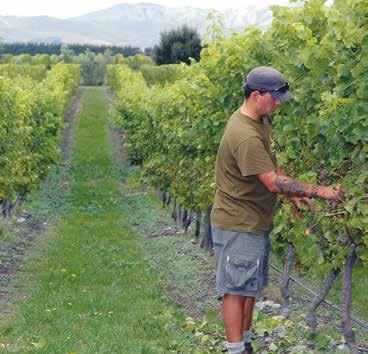

AS ANALYTICAL test-
ing company Hill Labs celebrates its 40th anniversary this year, managing director Jonno Hill credits the success of the company to the legacy of strong cultural values of the founders, his parents.
Started in 1984 by Dr Roger and Anne Hill, Hill Labs has grown to become New Zealand’s largest privately owned analytical laboratory. They use the latest technologies to supply a broad range of laboratory tests to domestic and international markets in the agricultural, environmental and food industries.
Jonno has spent his entire career working in the company his parents founded, but neither he nor his parents really saw him coming to join the family business when he was younger.
“It was not until I was six months before finishing my PhD that I even considered it, to be honest. It seems crazy in hindsight because it’s gone so well,” reflects Jonno.
Taking on the managing director role in 2018, Jonno says it’s been a wonderful exercise in experiencing intergenerational family business and the persistence of culture.
“Company culture and values accrue around the people who are leading
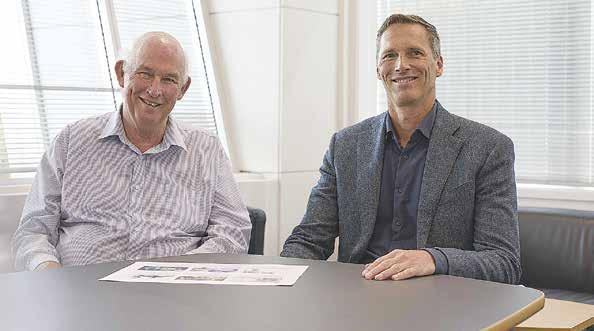
the business. Hill Labs was my parents’ business, and so the culture and the values reflect the things that they cared about. Of course, growing up I was also strongly influenced by those same values held by my folks, and so I think that’s maybe why the company just feels like it fits so well. It almost felt like coming home when I joined the business,” says Jonno.
This sentiment is also shared by many of Hill Labs’ employees. Senior technician Gina McNamara has been with Hill Labs coming up to 23 years and says that during her time with the company, they’ve formed a real community.
“There’s quite a few of us still here now that
LOOKING TO the future, Jonno is keen to preserve the things that underpin Hill Labs’ success but says he’s really energised by change and the myriad challenges that New Zealand and various markets are facing.
This gives way to huge opportunities for innovation in primary industries and the environmental space.
“Innovation is almost like a magic trick – it’s one of the ways that you bring new value into the world. You’re creating something valuable out of thin air really, and businesses that innovate are doing such a favour to the markets they’re in because they are creating new value and solutions where there was nothing before.”
According to Jonno some of these innovations are going to be driven by technology, and some will come from being
have been there since the beginning of my career. Together we’ve been through weddings,
clever in established areas by finding new ways to work with partners and customers.
“I generally see challenge and opportunity as two sides of the same coin. I’m looking forward to seeing how our business will change over time, and I’m open minded as to who we could be, and what we could be doing.
“That will be led by knowing what our customers need from us in the future, and where we believe we can be market leaders as our organisational capability continues to evolve.”
Creating and delivering new solutions is what will see the company continue to grow into the future, confirms Jonno, who says that the company’s growth aspirations will see them continue to take measured risks, though never with quality.
births, and all sorts of milestones that you would celebrate with your close friends and
family. There’s certainly a sense that we’re working together for something special, and that’s one
of the best parts about working for Hill Labs.”
Jonno believes it’s important for leadership to be attentive and intentional in recognising and articulating these foundational elements and shaping the company’s ethos into words and actions.
This commitment to the values of the past isn’t hindering them from focusing on the future, in fact, he says it helps Hill Labs create a competitive edge.
“I really love the idea of preserving, nurturing, and growing the legacy of my parents. It doesn’t mean that we’re frozen in time. The business does evolve, but it’s certainly an evolution rather than a revolution, we like to say.
“When we’re recruiting, particularly towards senior roles, we’re really explicit about our company values because it helps us attract the kind of people whose personal values match with ours. This improves our chances of appointing people who are going to be a good fit for the business,” explains Jonno.
A good fit for the business means having people join the team who are there for the long run and who know the value of taking a customercentric approach. Senior client service manager for key accounts, Graham
Corban, has been with the company for 30 years and says that there’s immense satisfaction in the company still being around and being stronger than ever – all while sticking to the values and ways of doing business that they felt was important.
“One thing that I really appreciate about Hill Labs’ leadership is that they have the courage to expand, grow and take risks, and as a business, we’ve deliberately chosen to focus on providing value to our clients,” says Corban.
Customer value is one of the key drivers that keep Hill Labs innovating now and will continue to do so in the future.
“When thinking about customer value, it all comes down to what people really care about. We know it’s turnaround time, it’s quality, and it’s customer service. And that leads us to think about how we manage our operations so that we can deliver those things,” says Jonno.
“For us, operational excellence means having really good, streamlined processes, leveraging scale where we have it. And a really important ingredient for us, and it’s one of the benefits of being privately owned, is that we invest heavily back into the business.”
BEEF+LAMB NZ’S
farmer councillors and extension team are using new methods, including diving into regional insights and data, to develop annual regional delivery plans (RDPs).
These RDPs, set to be completed and shared with farmers in late September, will guide B+LNZ’s extension programme for 2024-25 and beyond, that it says will prioritise B+LNZ’s investments of both time and levy to meet regional farmer priorities and needs.
Each of B+LNZ’s seven farmer councils across New Zealand, alongside their extension team, produce an annual RDP to address the unique needs of farmers across the country and setting goals that will ‘shift the dial’ for farmers in each region.
This year, farmer councillors and the extension team adopted a new
B+LNZ HAS launched its refreshed strategy that it says is a deliberate refocus on enhancing and sustaining on-farm productivity and profitability.
“These RDPs are critical to the partnership with our B+LNZ farmer council, ensuring B+LNZ extension work is guided by farmers, for farmers, focusing on and delivering regional needs,” says Justine Kidd.
B+LNZ established the farmer council to provide a pathway for farmers to lead, support and engage with B+LNZ’s regional extension by setting regional priorities, helping with identifying critical topics and supporting the extension team to deliver events and activities that farmers want.
“Farmer councils are a key sounding board for B+LNZ. They are our extension team’s critical partner, representing farmers and providing advice to guide decision-making and support us in delivering value to our farmers,” says Kidd.
data-driven approach: they interviewed farmers and rural professionals, gathering a broad range of insights. This was combined with regional information and data from B+LNZ’s Insights team, including farm numbers, scale, type, land use, farm performance, cropping and nutrients, and envi-
ronmental issues, to gain a deeper understanding of the opportunities and challenges faced by farmers.
With all this information, the farmer council and extension team ‘workshopped’ their plan, from an overarching guiding statement through to five focus areas with
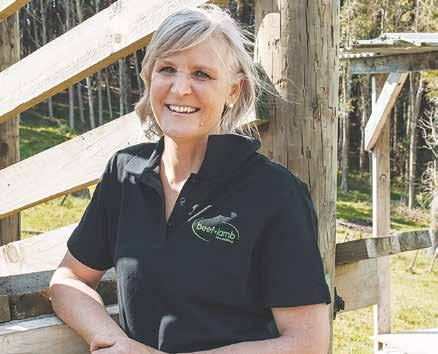
objectives and goals for the extension team to develop the RDP.
B+LNZ’s general manager extension, Justine Kidd, says they want to ensure that before drafting the RDPs, each region has a solid understanding of farm and farmer demographics and performance in their area.
“It is important to directly engage with farmers to identify local priorities and their unique opportunities and challenges.”
While each region’s RDP is tailored to its specific opportunities and challenges and reflect regional farm systems, there were also common
themes that emerged across the country.
“Some of the important areas identified by all regions was a focus on farm business performance, financial management and confidence, farmer wellbeing, production efficiencies, feed management and planning, staff management
ANNA ENGLAND from Elliot’s Wholesale Nursery in Amberley has been named as the 2024 Young Plant Producer of the Year.
The award, presented recently at a dinner in Christchurch, was reward for England’s dedication and innovation in the plant production industry.
The Young Plant Producer event tested competitors on the skills needed to run a successful plant production. It is organised by NZ Plant Producers (NZPPI), hosted by IPPS (International Plant Propagators’ Society) and supported by the Horticentre Charitable Trust.
The four finalists undertook two days of challenges at Lincoln University, where they were tested on their skills in finance and dispatch, biosecurity, plant propagation and identification, tool maintenance, agrichemical use and irrigation.
The judges looked for individuals who could make a difference in the industry, going beyond great skills to also include leadership, attitude and personality.
England is sales coordinator at Elliott’s Wholesale Nursery. Along with her trophy, she has won a 12-month programme of mentorship support plus a $3000 fund to advance her career in plant production. She
will also take part in the Young Horticulturalist of the Year award in November where she will compete against finalists from the entire horticulture sector, vying for a prize pool worth more than $20,000.
England moved to Christchurch from Taranaki four years ago to study horticulture at Lincoln University then joined the team at Elliot’s in a role she loves as it “offers with both incredible plants and fantastic people”.
“My time in horticulture so far has been a rewarding journey, and I’m grateful to be part of such a supportive industry. I saw the young plant producer competition as an opportunity to challenge myself to develop new skills and knowledge, as well as a great chance to meet other inspired people who are committed to the industry.”
The Young Plant Producer 2024 runners up were:
• Ellen Ballantine, Team Lead R&D Operations of vegetable breeding company, Enza Zaden in Puni, Auckland
• Johannes Andresen, despatch manager and sales at Tharfield Nursery in Katikati
• Jessica Jack,
and innovation.”
These draft RDPs were discussed at the June B+LNZ Farmer Council Conference to provide a national view.
“The data provided by the B+LNZ Insights team enabled us to have some really insightful discussions at our RDP workshops and at the recent conference.
“The sharing of our farmer councillors’ ideas and perspectives from across all regions was really impactful. It highlighted the great work that is being done for our farmers across the country,” she adds.
B+LNZ’s extension team is now adding delivery detail to the plan, phasing delivery activity and budgets, and the proposed final plan will be presented back for regional B+LNZ farmer councils to review. B+LNZ will share the finalised RDPs with farmers in late September.

EMERGING RESEARCH
highlights mice as a critical yet underestimated source of leptospirosis, emphasising the need for improved strategies to control the spread of the infectious disease.
Led by researchers from Massey University, in collaboration with ecologists from the University of Auckland and wildlife vets from Brazil, the study aimed to assess the density of infected mice within populations and understand their implications for disease transmission on a broader scale.
The findings revealed notable fluctuations in both the prevalence and density of mice, with an unexpected discovery that these metrics fluctuated in reverse directions.
Lead researcher Dr Marie Moinet says the discovery that the disease dynamics
do not follow standard epidemiological theory has important implications.
“Our data shows that the risk of getting leptospirosis remains significant regardless of fluctuations in mouse density. Even at lower densities, roughly nine out of ten mice were infected, indicating a persistent risk. Additionally, infected mice tend to roam more extensively, potentially spreading the disease further. Increased awareness of mice as a source of leptospirosis is essential, especially since we are often in closer contact with them than we realise. The recent trend of mice sighted in supermarkets is a good reminder of that!”
By integrating ecological and epidemiological methodologies, the research provides new

symptoms. Early diagnosis and antibiotic treatment is critical.

insights into wildlife disease dynamics, with mice being underemphasised as disease carriers within Aotearoa New Zealand.
Given the ubiquitous presence of mice across the country, their population sizes often go unnoticed until they reach outbreak level. Moinet says it heightens the risk for infection but misconceptions around the disease can cause further
complications.
“Leptospirosis cases and strains have historically been linked to livestock, creating the misconception that it’s only a farmer’s disease. Contact with infected mammal urine or contaminated water poses a significant transmission risk, with house mice harbouring the prominent Ballum strain in recent cases.




“The lack of awareness sets a dangerous precedent for those not in direct contact with livestock to be misdiagnosed or not receive proper treatment despite the need of a timely diagnosis.”
Infected individuals can show a wide range of symptoms, from asymptomatic to severe, including headache, fever, meningitis and kidney failure. Two-thirds of reported cases result in hospitalisation, averaging four nights, with half experiencing long-lasting
“While current control measures of leptospirosis are tailored for livestock strains, our study underlines the need for strategies that address rodent-associated strains. Awareness is the key to mitigation, particularly among health care providers, as anyone in contact with mice, including trampers, gardeners and urban residents, is at risk,” Moinet says.
Conducted over two years in a farm setting, the study involved humane trapping and testing of mice for Leptospira. While focused on a specific geographic area, the findings call for similar studies in urban settings to fully grasp the disease’s urban environments.
Professor Jackie Benschop says the research shows the need for comprehensive strategies to mitigate leptospirosis risk.
“The data reinforces previous findings linking rodent activity to disease transmission, marking the need for greater attention to rodent control to safeguard public health. Pest control measures should not be limited to times of high density, and it’s likely climate change and our recent flooding incidents will aggravate the problem.”
The collaborative research was completed by Dr Marie Moinet, Professor Jackie Benschop, Dr David Wilkinson and Dr Emilie Vallee of Massey University, Professor James Russell of University of Auckland Dr Carlos Abarahão and Dr Vinícius Gasparotto from the Brazilian Institute for Conservation Medicine.
The study is published in the Journal of Applied Ecology: Density matters: How population dynamics of house mice (Mus musculus) inform the epidemiology of Leptospira.
LEPTOSPIROSIS IS a bacterial infection of humans and animals.
Farmers, their families, meat workers, vets, stock agents and rural transport truck drivers are among those most exposed to the bacteria in New Zealand, which is shed in the urine of infected animals, such as deer, pigs, cattle, sheep and dogs, as well as wild mammals (rats, mice, possums, hedgehogs) and passed on to humans through cuts in the skin or through the membranes of the eyes, nose or mouth. Overseas, flooding and poverty are the most common exposures.
In infected humans, leptospirosis presents as a serious flu-like illness, which if not treated promptly can lead to long-term health effects and in rare cases – death.
Massey University reports that leptospirosis leads to hospital admissions in 70% of cases, with half of patients experiencing longer term illness.
Symptoms of severe illness can include kidney and liver damage. Some people may be unable to return to work for months and in severe cases, unable to return at all due to symptoms of chronic fatigue. The disease can keep coming back. There is also overseas research indicating the disease may cause miscarriages in pregnant women and a cautious approach is recommended.
Livestock tend to be infected with leptospirosis strains that are well adapted to them, so stock appear
unaffected yet still shed the bug in their urine. When impacted by poor nutrition, floods or other stressors, stock may show reduced production and reproduction. However, when infected with a different strain and if that is combined with severe stress then severe outbreaks of the disease can occur with death in young stock and abortion storms.
Leptospirosis is contracted mostly through exposure to the urine of infected animals, either through direct contact or via contaminated water. The bacteria enter through cuts or grazes on our skin, or through the mucous membranes of our eyes, nose and mouth.
New Zealand has one of the highest rates of leptospirosis in countries with temperate climates in the world. Last year there were 170 cases notified, nearly all in people living rurally. This is the tip of the iceberg as there are many cases missed because lepto looks like Covid or the flu and there are issues with getting a diagnosis.
Current data from Massey University shows that 70% of people suspected of having leptospirosis are not tested for it.
The annual number of notified leptospirosis cases fell dramatically between 1980 and 2000 but has fluctuated since. Unfortunately, it is on the rise again in flood-affected regions as the disease can be spread through contact with animals or with soil and water contaminated by animals.
WHILE NEW Zealand’s clever thinkers were out in full force at the Fieldays Innovations event last month, the youngsters weren’t there to be overlooked.
Indeed, Iona College from the Hawke’s Bay’s, inspired by previous junior winners, entered for the first time, only to walk away with the Young Innovator of the Year Award.
Their ‘Wool Be Studying’ 100% Wool Study Pod was a collaborative project focused on wool within the Design Technology class, led by Year 13 student Phoebe Butler and Year 12 student Maddie Foote, supported by head of technology Kirsten Le Bon and deputy principal Stephanie Russell.
The key entry criteria was that the innovation must have application in the food and fibre sector. Kirsten Le Bon was a strong advocate for sustainability and using wool and natural resources in many of the students’ projects. Butler and Russell both live on sheep and beef farms and were keen to support successful innovation using strong wool as a highvalue product.
Their innovation project, ‘Wool Be Studying’, is a prototype study pod paired with 100% sustain-

able flat pack furniture, designed to provide a quiet, functional space for individuals in workplaces, study areas or libraries to work efficiently. The project emphasises the versatility and sustainability of wool in modern design whilst also offering the advantages of being sound-reducing, breathable, durable and portable.
The innovative pod has been shaped by the collective efforts of many designers, architects, manufacturers, and institutions seeking to meet the evolving needs of modern work and study environments. Collaborative thinking between students and college staff
established that wool has many qualities that lend well to the concept of a pod being breathable, sound-absorbing, durable and 100% natural.
Designed, developed and constructed fully within the Iona College Design Technology classroom, fabric samples, wooden blocks, and tent poles were used to construct initial prototypes, while mathematical modelling was applied to finalise the pod pattern for construction.
Practical considerations saw multiple students sit in the pod to test the height and ideal dimensions to accommodate a desk and chair, with the combined height
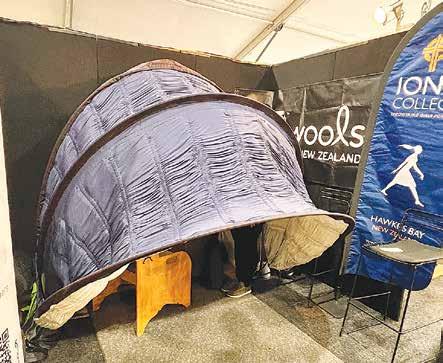
and width proportions tweaked to ensure a comfortable space for both students and adults.
Development overcame a key challenge of the woollen canopy bearing down on the structure, leading to the final prototype design using PVC pipes and fittings to replace the original frame and strengthen the front band, which is designed to be placed against a window to reduce any feelings of claustrophobia, and bring light into the pod.
During the project, students were mindful of the levels of skill required to develop prototypes and the costs associated, aided by major spon-
sor, Big Save and others including the Fabric Store, who helped with development costs.
Iona College principal Willy Kersten says he is proud of the girls’ achievements, both in terms of gaining a finalist place, but also in receiving the People’s Choice award across the 62 entries in the Innovation category.
“The high level of interest in the girls’ work has emerged, not only because of the product itself, but because of the girls’ ability to articulate clearly all aspects of the project they embarked on; from concept to rationale, research, design and construction.”
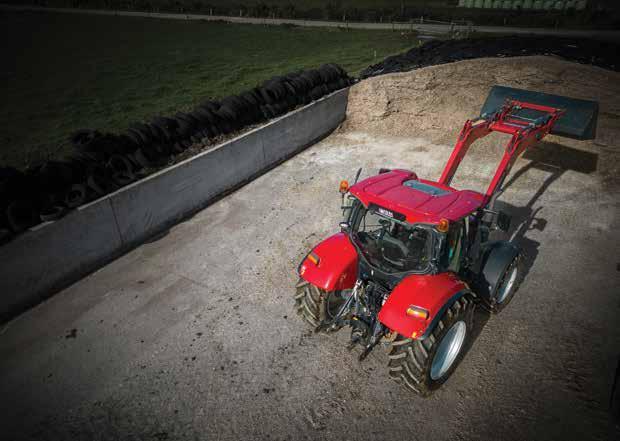

across the world.
A T7.225 with candy blue body panels, New Holland silver and black graphics featuring the Union Jack flag, black wheels rims with candy blue rim edges, plus a NH leaf on the bonnet top is obviously something special.
Indeed, a ‘2,000,000 Basildon Tractors’ logo gives the game away, in the same year as it celebrates 60 years of tractor production. The New Holland plant at Basildon, England, is now celebrating the manufacture of its two millionth tractor, a feat managed by only a handful of such facilities
The Basildon factory, on a nondescript industrial estate in Essex, UK was opened in 1964 to coincide with the introduction of the 37-65hp Ford 6X tractor series, with familiar names such as the 2000 Dexta, 3000 Super Dexta, 4000 Major and 5000 Super Major models. Within two years the plant had produced 100,000 of these tractors, with these models eventually becoming the ‘Pre-Force’ series, following the 1968 launch of the ‘Ford Force’ 2000/3000/4000 and 5000 tractors, with the 250,000th tractor being produced in 1969.
The 500,000th trac-

tor was made in 1984, an example from the Q-cabbed Series 10 range that had launched three years previously, with a range that eventually spanned from the 44hp
2610 to the 116hp 8210 models.
Five years later, coinciding with the launch of the Generation III evolution of the Series 10 range in 1989, Basildon

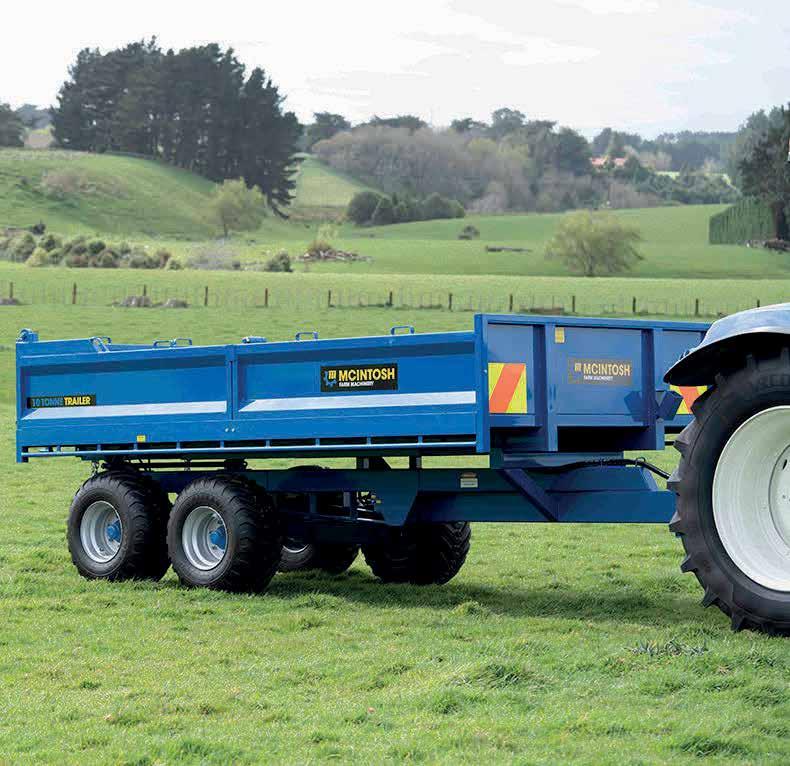


produced its one millionth tractor. The year also marked 25 years of manufacturing at the plant, to be celebrated with the release of a number of now much
sought after special edition Silver Jubilee 7810 tractors.
In 1995, the factory produced number 1,500,000 – a Series 40 model – four years after it came under new ownership following the purchase of the Ford New Holland agricultural equipment business by Fiat, creating today’s New Holland brand. Fast forward to July 2024 and the 2 millionth tractor is a milestone for Basildon and the New Holland brand.
Carlo Lambro, New Holland brand president, said “from the tractors of 1964 to those of today, we have come a long way in capability, capacity and
technology, allowing our customers to farm more efficiently”.
“The milestone marks the dedication of our skilled employees at the plant and the loyalty of our customers worldwide. What is unchanged, though, is our commitment at Basildon and across the whole of our business to continue developing the technology our customers’ need to sustainably power their farms into the future.”
Scheduled to make special appearances during forthcoming events in the UK, the diamond anniversary tractor will then be displayed in the customer centre at Basildon.
Aitchison drill range, which has a history that dates back more than 54 years.
PALMERSTON NORTH company
Farmgear Limited is well known for its wide range of popular brands.
Indeed, their first product, the Maxam mower developed in 1998 – a concept that combines a mower and a topper – is still selling well 26 years later.
In 2009, the company purchased Fencepro and relocated the business from Wellsford to Palmerston North, from where it became a dominant player in the New Zealand post driver market, particularly the Ultra range, which is popular with fencing contractors.
In 2019, Farmgear acquired Fairbrother Industries, taking over wellknown brands like Kinghitter and Hooper. The move saw production move from Auckland’s Beachhaven area to Palmerston North, but despite the Fencepro and Kinghitter ranges being built on the same site, each brand has gone on to establish its own identity within the market.
Earlier this year, the company took over the Reese Engineering business that was in liquidation, along with its product lines and a production site on the outskirts of Feilding. Rationalisation of the product offering has seen the Agrispread ranges sold to Redback Global, while the former Aitchison weight transfer roller has moved to Agtec Machinery in Masterton.
Farmgear’s intention is to focus on the simplicity and reliability of the
Farmgear sales and marketing manager Grant Barnes says their focus is refining the drill ranges that over the years have become a firm favourite of NZ farmers. “We won’t be making changes for change’s sake, more a case of tweaking and improving to make the machines easier to produce, use and maintain.”
The 3000 Series Grassfarmer is available in Tine, T-boot and concave disc opener versions.
Available with 14 or 18 discs, offering a 150mm (6-inch) spacing, delivering a 2.1 or 2.7m sowing width, both examples feature an infinitely variable seed metering system and the Aitchison developed, sponge-based seed delivery system.
The Seedmatic Mark 4 Series drills feature vibrating 25mm section tines allowing the unit to handle trash, a slimline boot holder and ni-hard boots. Offered in 2.5, 3.0 and 3.5 metre sowing widths with 20, 24 or 28 rows respectively, row spacing is 125mm (5-inch), in seed-only or seed and fertiliser versions.
A 410mm frame stagger offers excellent trash clearance, allowing the drills to be used for renovation of existing pastures, or sowing a wide range of crops into cultivated soils or maize stubbles.
Ahead of the tines, a full-width 14-inch disc system helps cut a path through heavy trash burdens or matted grassland.
www.farmgear.co.nz
